Top 12 Sheet Metal Mechanic Skills to Put on Your Resume
In the competitive field of sheet metal mechanics, showcasing the right set of skills on your resume can make a significant difference in landing your next job. This article highlights the top 12 skills that employers look for in a sheet metal mechanic, helping you stand out in the job market and move your career forward.
Sheet Metal Mechanic Skills
- AutoCAD
- SolidWorks
- TIG Welding
- MIG Welding
- Plasma Cutting
- CNC Programming
- Precision Measuring
- Brake Press Operation
- Shearing Machines
- Riveting Techniques
- Sheet Metal Layout
- HVAC Systems
1. AutoCAD
AutoCAD is a computer-aided design (CAD) platform for drafting precise 2D and 3D drawings, including fabrication details and layouts for sheet metal parts and assemblies.
Why It's Important
AutoCAD gives a Sheet Metal Mechanic the power to translate ideas into exact drawings. Clean geometry, accurate dimensions, fewer mistakes on the floor. Faster fabrication, less scrap, better results.
How to Improve AutoCAD Skills
Sharpening your AutoCAD chops pays off quickly:
Master Shortcuts: Build speed with keyboard commands and aliases tailored to your workflow.
Use Templates: Create project templates with layers, linetypes, title blocks, and standards baked in.
Customize Tool Palettes: Store common parts, blocks, and commands for one-click access during layout.
Dive Into 3D: Learn basic 3D modeling to visualize bends, clearances, and fit-up before cutting metal.
Leverage Sheet Metal Tools: Explore mechanical toolsets or companion software that handle bend allowances, K-factors, and flat patterns.
Iterate and Stay Current: Practice on real jobs, experiment with features, and keep up with new releases.
Dialed-in habits make drawings tighter, faster, and easier to fabricate.
How to Display AutoCAD Skills on Your Resume
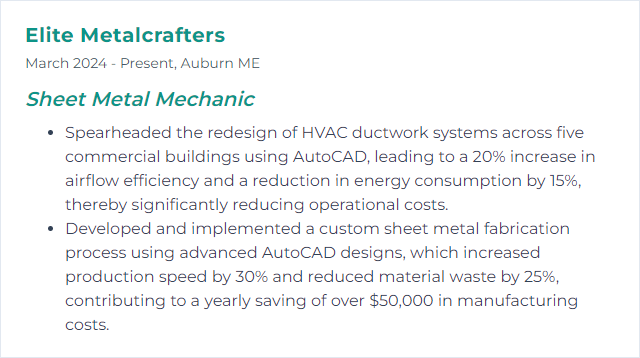
2. SolidWorks
SolidWorks is a CAD suite for building 2D and 3D models, with dedicated sheet metal features for flanges, hems, reliefs, and flat pattern generation—great for visualizing and validating parts before fabrication.
Why It's Important
It lets you model complex parts, check interferences, unfold to flats with correct bend deductions, and adjust on the fly. Less rework. More predictable fit.
How to Improve SolidWorks Skills
Make your models smarter and your process smoother:
Nail the Fundamentals: Sketch relations, design intent, configurations—get these right and assemblies behave.
Focus on Sheet Metal: Use bend tables, K-factors, corner reliefs, and mitering. Validate flats against real brake capability.
Customize Your Workspace: Shortcuts, mouse gestures, templates, and library features reduce clicks and errors.
Use Simulation and Interference Checks: Catch clash issues and misalignments before they hit the shop.
Practice With Real Jobs: Build parts you actually fabricate. Iterate, document lessons, refine presets.
Keep Learning: New releases add tools—bend notes, drawings, MBD—make them work for you.
Master the sheet metal toolset and your flats will come out right the first time.
How to Display SolidWorks Skills on Your Resume
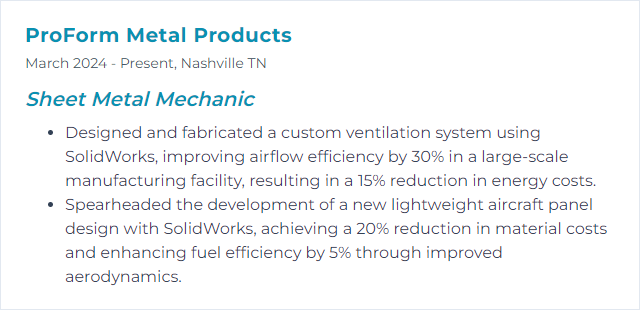
3. TIG Welding
TIG (Tungsten Inert Gas) welding uses a non-consumable tungsten electrode and inert shielding gas, delivering precise, clean welds—ideal for thin sheet, stainless, aluminum, and detailed assemblies.
Why It's Important
Fine control, beautiful beads, minimal spatter. Perfect for critical joints and thin-gauge work where distortion must stay low and appearance matters.
How to Improve TIG Welding Skills
Turn consistency into muscle memory:
Dial In Setup: Correct cup size, gas flow, tungsten type and grind, polarity, and amperage to suit material and thickness.
Prep Ruthlessly: Clean base metal and filler. Remove oxides and oil. Fit-up tight to control heat and distortion.
Control the Arc: Maintain torch angle and arc length. Feed filler smoothly into the leading edge of the puddle.
Manage Heat: Use foot pedal control, pulse features, and chill blocks. Weld in short runs to avoid warping.
Practice on Coupons: Vary positions, joints, and materials. Inspect results, cut-and-etch to verify penetration.
Precision rises when prep, setup, and steady technique come together.
How to Display TIG Welding Skills on Your Resume

4. MIG Welding
MIG (Gas Metal Arc) welding feeds a consumable wire through a gun under shielding gas. Fast, versatile, and friendly to production on mild steel, stainless, and aluminum with the right setup.
Why It's Important
It delivers speed with reliable quality. Great for sheet assemblies, brackets, frames, and repair—especially when throughput matters.
How to Improve MIG Welding Skills
Smoother beads, fewer burn-throughs:
Prep the Joint: Clean to bright metal. Remove paint, rust, and oil. Good fit-up pays dividends.
Match Wire and Gas: Choose wire alloy and diameter for the job. Set voltage, wire feed, and gas flow for thickness and position.
Refine Technique: Keep a steady travel speed and consistent stickout. For thin sheet, a push technique helps reduce penetration and spatter.
Tame Heat: Stitch weld, skip around, or backstep to limit distortion. Use copper backing when needed.
Test and Record: Run test coupons, note settings that work, and build a quick-reference chart.
Repeatable settings plus clean preparation equals tidy welds and fewer do-overs.
How to Display MIG Welding Skills on Your Resume
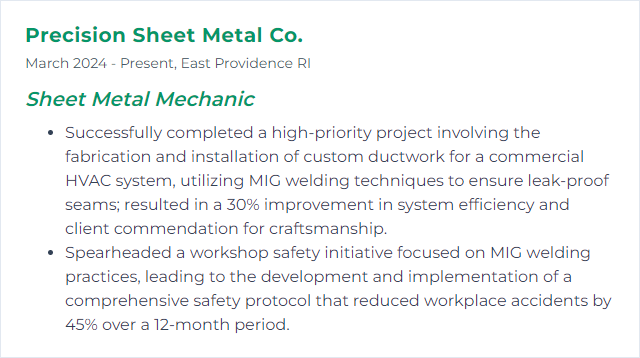
5. Plasma Cutting
Plasma cutting drives a jet of superheated, ionized gas through metal, slicing cleanly through conductive material with speed and precision.
Why It's Important
It handles varied thicknesses with accuracy, trims lead time, and supports complex geometry—perfect for shop flow that can’t afford bottlenecks.
How to Improve Plasma Cutting Skills
Cleaner edges, longer consumable life:
Maintain the Torch: Replace worn nozzles and electrodes early. Keep connections tight and airflow dry.
Set for Thickness: Match amperage and travel speed to the material. Use charts, then fine-tune by cut quality and dross.
Hold the Right Standoff: Keep a consistent torch height, perpendicular to the work. Use guides or a CNC table where possible.
Prep Material: Clean the surface and support the sheet flat. Secure it to prevent chatter and tipping.
Prioritize Safety: Vent fumes, protect eyes and skin, and keep sparks away from anything flammable.
The payoff shows up in crisp kerfs, minimal cleanup, and predictable cuts.
How to Display Plasma Cutting Skills on Your Resume

6. CNC Programming
CNC programming converts designs into machine instructions for cutting, forming, and shaping sheet metal parts with consistent accuracy.
Why It's Important
Repeatability, tight tolerances, and efficiency. Programs run day after day, yielding parts that match prints and keep waste down.
How to Improve CNC Programming Skills
Make every cycle count:
Master CAD/CAM: Use sheet metal-aware tools for flats, nests, bend deductions, and post-processing tailored to your machines.
Know Your Materials: Adjust feeds, speeds, pierce times, and bend allowances by alloy and thickness.
Optimize Toolpaths: Shorten moves, reduce retracts, and order operations to manage heat and minimize distortion.
Understand G/M Code: Read and tweak code for edge cases, offsets, and quick fixes on the floor.
Standardize: Build proven libraries for tools, offsets, and setups. Document what works and reuse it.
Validate: Simulate first, run test pieces, and measure results. Feed findings back into your posts and templates.
Good programming shortens setup times and keeps quality steady across shifts.
How to Display CNC Programming Skills on Your Resume
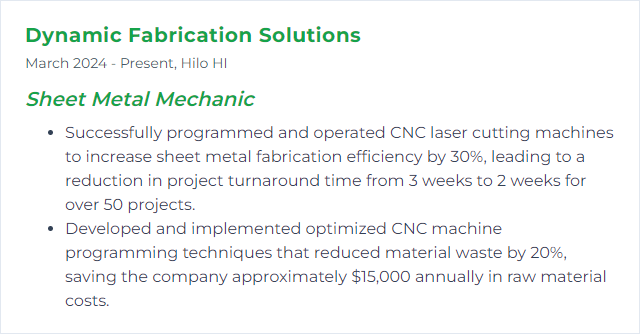
7. Precision Measuring
Precision measuring uses tools like calipers, micrometers, height gauges, and protractors to verify thickness, dimensions, and angles against tight tolerances.
Why It's Important
Parts fit. Holes line up. Assemblies go together without persuasion. Accurate measurement prevents scrap and keeps quality locked in.
How to Improve Precision Measuring Skills
Accuracy starts before the first measurement:
Use Quality Instruments: Reliable calipers, micrometers, angle finders, and gauges that hold calibration.
Calibrate Regularly: Follow a schedule. Keep certs. Check against gauge blocks or standards.
Handle With Care: Clean, store, and transport tools properly to avoid drift and damage.
Control the Environment: Measure at stable temperatures. Let parts acclimate. Watch humidity for sensitive checks.
Build Skill: Practice consistent technique—feel on micrometers, squareness on setups, alignment on angles.
Cross-Check: Verify with a second tool or method when tolerances are tight.
Small habits add up to dependable numbers and fewer surprises.
How to Display Precision Measuring Skills on Your Resume

8. Brake Press Operation
Brake press operation bends sheet metal to precise angles and forms using matched tooling and controlled force.
Why It's Important
It transforms flats into finished geometry. Accurate bends mean parts assemble cleanly and meet print without shimming or wrestling.
How to Improve Brake Press Operation Skills
Better bends, fewer reruns:
Invest in Training: Bend allowances, springback, tooling selection, and safety—learn them deeply.
Maintain the Machine: Keep rams aligned, hydraulics healthy, and backgauges accurate.
Tooling Discipline: Use the right punches and dies. Label, store, and inspect tooling to keep results consistent.
Program Smart: Use offline bend simulation, sequenced programs, and documented setups to reduce scrap.
Prioritize Safety: Guards, light curtains, safe hand positions, and clear procedures—no shortcuts.
Consistency comes from solid setup, clean tooling, and repeatable programs.
How to Display Brake Press Operation Skills on Your Resume
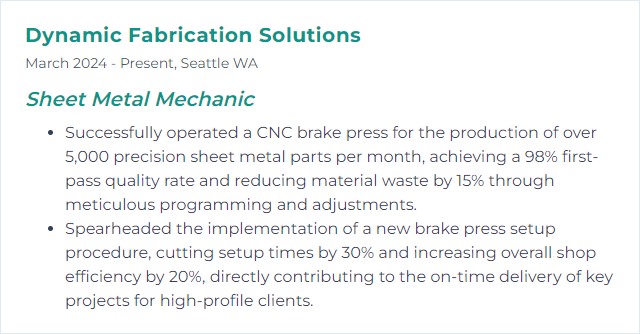
9. Shearing Machines
Shearing machines cut sheet stock along straight lines using an upper and lower blade, quickly producing blanks and strips with clean edges.
Why It's Important
They’re fast, predictable, and economical for straight cuts—perfect for prepping material before forming or secondary ops.
How to Improve Shearing Machines Skills
Sharper cuts, safer workflow:
Safety First: Train operators, check guards, and enforce safe hand positions and foot pedal controls.
Keep It Aligned: Maintain blade gap and rake for the material. Check squareness and backgauge accuracy.
Upgrade Blades: Use the proper blade material for the alloys you cut and sharpen on schedule.
Streamline Handling: Add support arms, ball transfers, or conveyors to move sheets with less strain and fewer scratches.
Plan for Uptime: Preventive maintenance, lubrication, and routine inspections prevent surprise downtime.
Reduce Energy Waste: Power down when idle and consider efficient hydraulics or controls where feasible.
Attention to setup and maintenance shows up in edge quality and throughput.
How to Display Shearing Machines Skills on Your Resume

10. Riveting Techniques
Riveting joins sheet metal by inserting a rivet through matched holes and deforming the tail to clamp the materials. Includes solid, blind (pop), and specialty rivets depending on strength and access.
Why It's Important
When welding isn’t the answer, rivets deliver durable, lightweight, and reliable connections—especially in thin-gauge and multi-material assemblies.
How to Improve Riveting Techniques Skills
Cleaner installs, stronger joints:
Choose Correct Rivets: Match material, diameter, grip length, and head style to the job.
Prep and Deburr: Clean surfaces and remove burrs for tight seating and long-term durability.
Drill True: Use the right bit size and keep holes perpendicular. A drill press or proper fixturing helps.
Use Proper Technique: Keep the tool square, apply steady pressure, and support the work with a bucking bar when needed.
Inspect Every Time: Check head formation, clamp-up, and alignment. Reject loose or malformed rivets.
Practice: Run samples on scrap with the same stack-up to confirm grip and technique.
Good riveting feels smooth, looks uniform, and stays tight under load.
How to Display Riveting Techniques Skills on Your Resume
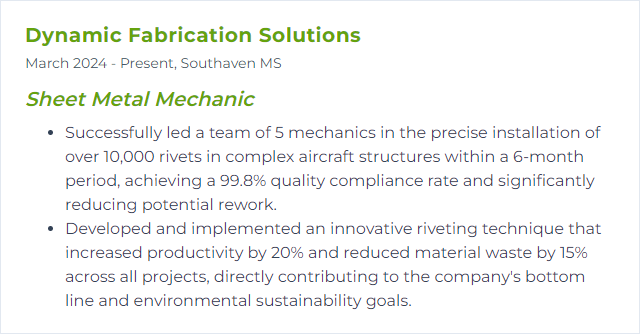
11. Sheet Metal Layout
Sheet metal layout plans and marks cut lines, bend lines, and allowances on flat stock so parts form to the correct final dimensions.
Why It's Important
Accurate layouts prevent rework and waste. When the flat is right, bends land where they should and assemblies fit.
How to Improve Sheet Metal Layout Skills
Get the flat perfect before the first cut:
Use CAD and CAM: Generate flats with correct K-factors and bend deductions. Drive consistent results across jobs.
Standardize: Create process sheets, templates, and checklists for common parts and features.
Nesting Matters: Arrange parts to maximize yield while respecting grain, bend direction, and tool access.
Keep Tools Sharp: Squares, scribes, transfer punches, and gauges should be clean and accurate.
Quality at Each Step: Verify critical dimensions after cut and after first-off bends before running the lot.
Think Lean: Shorten travel, reduce handling, and stage materials to keep flow smooth.
Clear marks and precise data lead to predictable bends and tidy assemblies.
How to Display Sheet Metal Layout Skills on Your Resume
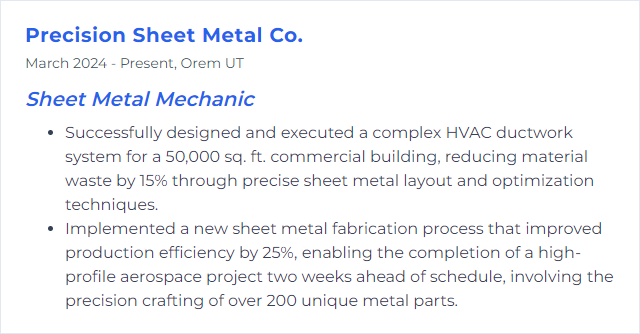
12. HVAC Systems
HVAC—Heating, Ventilation, and Air Conditioning—relies on well-built ductwork and sheet metal components to move air efficiently and quietly through a building.
Why It's Important
Comfort, air quality, and efficiency all depend on tight, balanced duct systems. Sheet Metal Mechanics make that performance real in the field and shop.
How to Improve HVAC Systems Skills
Make systems breathe easier:
Seal and Insulate: Tight joints and proper insulation curb losses and noise while boosting efficiency.
Size It Right: Use load and duct calculations to match airflow and pressure to the space and equipment.
Smooth Airflow: Favor gradual transitions, correct radius elbows, and minimal restrictions to cut static pressure.
Maintain Regularly: Clean coils, replace filters, and verify damper function to keep performance steady.
Leverage Controls: Smart thermostats and variable-speed fans adjust to demand and save energy.
Good design, careful fabrication, and clean installs produce quiet, efficient systems that last.
How to Display HVAC Systems Skills on Your Resume

